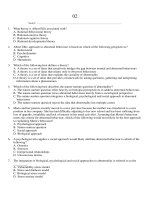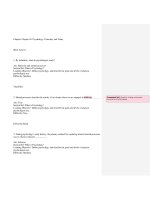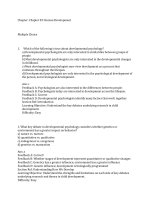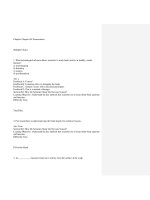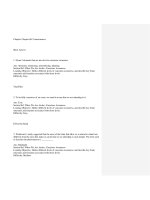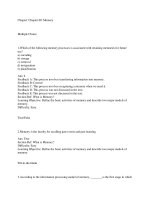TestBank psychology around us 2nd edition comer ch03
Bạn đang xem bản rút gọn của tài liệu. Xem và tải ngay bản đầy đủ của tài liệu tại đây (577.95 KB, 89 trang )
Chapter: Chapter 03: Human Development
Multiple Choice
1.
Which of the following is true about developmental psychology?
a) Developmental psychologists are only interested in similarities between groups of
people.
b) Most developmental psychologists are only interested in the developmental changes
in childhood.
c) Most developmental psychologists now view development as a process that
continues throughout the lifespan.
d) Developmental psychologists are only interested in the psychological development of
the person, not in biological development.
Ans: c
Feedback A: Psychologists are also interested in the differences between people.
Feedback B: Psychologists today are interested in development across the lifespan.
Feedback C: Correct
Feedback D: Developmental psychologists identify many factors that work together.
Section Ref: Introduction
Learning Objective: Understand the key debates underlying research in child
development.
Difficulty: Easy
1. What key debate in developmental psychology considers whether genetics or
environment has a greater impact on behavior?
a) nature vs. nurture
b) quantitative vs. qualitative
c) endogenous vs. exogenous
d) genetics vs. maturation
Ans: a
Feedback A: Correct!
Feedback B: Whether stages of development represent quantitative or qualitative changes
Feedback C: Genetics has a greater influence; environment has a greater influence
Feedback D: Genetic influence; development is biologically programmed
Section Ref: Understanding How We Develop
Learning Objective: Understand the strengths and limitations on each side of key debates
underlying research and theory in child development.
Difficulty: Easy
True/False
2. The belief that development is biologically programmed to happen sequentially is known
as maturation.
Ans: True
Section Ref: Understanding How We Develop
Learning Objective: Understand the strengths and limitations on each side of key debates
underlying research and theory in child development.
Difficulty: Easy
Fill-in-the-blank
3. The __________ view of development suggests that our experiences heavily influence how
we develop.
Ans: exogenous
Section Ref: Understanding How We Develop
Learning Objective: Understand the strengths and limitations on each side of key debates
underlying research and theory in child development.
Difficulty: Medium
Short Answer
4. What does the term “nature” refer to in the nature vs. nurture controversy?
Ans: Genetic inheritance
Section Ref: Understanding How We Develop
Learning Objective: Understand the strengths and limitations on each side of key debates
underlying research and theory in child development.
Difficulty: Easy
Essay
5. Which do you believe is more important: nature or nurture? Reflect on your own life
circumstances and determine whether your genetics or your environment has had a
greater impact on who you are today. Provide 2 examples to support your choice.
Ans: State whether nature or nurture is more important. State whether genetics or
environment has had a greater impact. Provide 2 relevant examples that support their
choice.
Section Ref: Understanding How We Develop
Learning Objective: Understand the strengths and limitations on each side of key debates
underlying research and theory in child development.
Difficulty: Medium
True/False
A stage is a developmental period characterized by a certain level of functioning that
is qualitatively different from the functioning that characterizes other stages.
Ans: True
Section Ref: Understanding How We Develop
Learning Objective: Understand the strengths and limitations on each side of key
debates underlying research and theory in child development.
Difficulty: Easy
7. All children develop in the same way and there is no variation in the timing of
developmental milestones.
Ans: False
Feedback: There are variations in the timing of developmental milestones that still fall
within the normal range.
Section Ref: Understanding How We Develop
Learning Objective: Understand the strengths and limitations on each side of key debates
underlying research and theory in child development.
Difficulty: Easy
Fill-in-the-blank
Stages represent ______ shifts in the growth of persons.
Ans: qualitative
Section Ref: Understanding How We Develop
Learning Objective: Understand the strengths and limitations on each side of key
debates underlying research and theory in child development.
Difficulty: Medium
Essay
Explain the difference between qualitative and quantitative shifts in growth and
give an example of each type of change.
Ans: Stages theorists believe that development is best explained by qualitative shifts
in the growth of persons. A qualitative shift occurs when individuals make
developmental jumps that cause them to be different than they were before.
Qualitative changes represent changes in form or kind. For example, when children
acquire language they begin to think about the world in a different. Other
psychologists disagree with the stage theory of development. They claim that
development comes from continuously acquiring new information and new
experiences. In their view, what may seem like a big, sudden developmental change
actually results from a gradual accumulation of many small changes in quantity.
Walking is a good example of an achievement that is built on small steady
developmental changes.
Section Ref: Understanding How We Develop
Learning Objective: Understand the strengths and limitations on each side of key
debates underlying research and theory in child development.
Difficulty: Hard
Multiple Choice
8. Which type of shifts in developmental growth suggest that a person changes following
the achievement of milestones.
a) quantitative
b) maturation
c) exogenous
d) qualitative
Ans: d
Feedback A: Variance in timing of developmental milestones.
Feedback B: Biologically programmed to happen sequentially
Feedback C: Belief that experiences have a greater influence on development
Feedback D: Correct!
Section Ref: Understanding How We Develop
Learning Objective: Understand the strengths and limitations on each side of key debates
underlying research and theory in child development.
Difficulty: Medium
The documentary Babies follows the development of babies from four different
cultures. This film shows that ______.
a) each baby develops in response to his or her particular environment.
b) babies are unaffected by cultural influences during their first year of
development.
c) Western babies achieve most physical, cognitive, and social milestones before
non-Western babies.
d) a baby’s behavior is virtually unaffected by genetic factors.
Ans: a
Feedback A: Correct
Feedback B: Babies are affected by cultural influences.
Feedback C: The text does not mention that Western babies achieve most developmental
milestones before non-Western babies.
Feedback D: Babies are affected by genetic influences.
Section Ref: Understanding how we develop
Learning Objective: Understand the key debates underlying research in child development.
Difficulty: Medium
Short Answer
9. What term is used to describe a point in development when an organism is especially
sensitive to particular kinds of environmental stimuli?
Ans: Critical period
Section Ref: Understanding How We Develop
Learning Objective: Understand the strengths and limitations on each side of key debates
underlying research and theory in child development.
Difficulty: Medium
Essay
10. Define the term “imprinting” and identify the scientist most often associated with this
research.
Ans: Lorenz coined the term imprinting to describe the attachment that young geese make
when they connect with the moving stimuli they are with most often during the first 36
hours of life.
Section Ref: Understanding How We Develop
Learning Objective: Understand the strengths and limitations on each side of key debates
underlying research and theory in child development.
Difficulty: Hard
11. Most developmental psychologists believe that
a) endogenous factors are more important than exogenous factors.
b) exogenous factors are more important than endogenous factors.
c) nature is more important than nurture.
d) development is a combination of exogenous and endogenous factors.
Ans: d
Feedback A: Both nature (endogenous) and nurture (exogenous) factors are important
aspects of development.
Feedback B: Both nature (endogenous) and nurture (exogenous) factors are important
aspects of development.
Feedback C: Both nature (endogenous) and nurture (exogenous) factors are important
aspects of development.
Feedback D: Correct
Section Ref: Understanding how we develop
Learning Objective: Understand the key debates underlying research in child
development.
Difficulty: Medium
13. Joseph recently found some duckling eggs that had been abandoned and hatched the
eggs. The ducklings followed Joseph around everywhere. Which of the following
experiments was Joseph replicating?
a) Lorenz’s studies of sensitive periods.
b) Lorenz’s studies of imprinting.
c) Piaget’s theory of attachment.
d) Bowlby’s studies of attachment.
Ans: b
Feedback A: Lorenz coined the term imprinting – not sensitive periods - to describe this
phenomenon.
Feedback B: Correct
Feedback C: Piaget studied cognitive development, not imprinting.
Feedback D: Bowlby studied human babies’ attachment styles.
Section Ref: Understanding how we develop
Learning Objective: Understand the key debates underlying research in child
development.
Difficulty: Medium
14.
If you encountered an eight week old kitten that had never been exposed to humans
before, what reaction would you most likely get from the kitten?
a) The kitten would be friendly because it has the genes of a domestic animal.
b) The kitten would bite and scratch you because it never imprinted on humans.
c) The kitten would respond the same way its mother responds.
d) The particular reaction would depend on the specific personality of the individual
kitten.
Ans: b
Feedback A: Behavior is a combination of both genes and environmental forces.
Feedback B: Correct
Feedback C: The kitten will respond like a wild animal because it never imprinted on
humans.
Feedback D: The kitten will respond like a wild animal because it never imprinted on
humans.
Section Ref: Understanding how we develop
Learning Objective: Understand the key debates underlying research in child
development.
Difficulty: Hard
15. What is the difference between a critical period and a sensitive period?
a) Critical periods are more rigid than sensitive periods.
b) Sensitive periods are more rigid than critical periods.
c) Animals have sensitive periods, while humans have critical periods.
d) Critical periods and sensitive periods are the same thing.
Ans: a
Feedback A: Correct
Feedback B: Sensitive periods are more flexible and more responsive to environmental
changes
Feedback C: The term sensitive periods is generally used to discuss human
development.
Feedback D: Sensitive periods are more flexible and more responsive to changes in
experience.
Section Ref: Understanding how we develop
Learning Objective: Understand the key debates underlying research in child
development.
Difficulty: Medium
16.
Mary is concerned that her baby is 12 months old, but is still not walking on her own.
Which of the following issues is most relevant to Mary’s concern?
a) Nature vs. nurture.
b) Critical periods vs. sensitive periods.
c) Qualitative vs. quantitative shifts in development.
d) Longitudinal vs. cross-sectional.
Ans: c
Feedback A: Individual variations in the timing of stages central to the issue of
qualitative vs. quantitative shifts in development.
Feedback B: Individual variations in the timing of stages central to the issue of
qualitative vs. quantitative shifts in development.
Feedback C: Correct
Feedback D: Individual variations in the timing of stages central to the issue of
qualitative vs. quantitative shifts in development.
Section Ref: Understanding how we develop
Learning Objective: Understand the key debates underlying research in child
development.
Difficulty: Hard
Short-Answer
What is an “impact” study?
Ans: When researchers conduct "impact" studies, they set children up in certain
predicaments and see how they handle the unexpected turn of events.
Section Ref: How is Developmental Psychology Investigated?
Learning Objective: Describe and discuss the advantages and disadvantages of
cross-sectional and longitudinal designs for researching development.
Difficulty: Easy
Why are questionnaires and interviews usually of limited use when conducting
research on children? Why would an "impact" study be particularly appropriate for
research on children?
Ans: Children often do not have sufficient insight into what factors drive their
behavior. This lack of introspection ability inhibits the usefulness of questionnaires
and interviews. Impact studies useful because they are based on behavioral
observation and do not require the child to engage in introspection.
Section Ref: How is Developmental Psychology Investigated?
Learning Objective: Describe and discuss the advantages and disadvantages of
cross-sectional and longitudinal designs for researching development.
Difficulty: Medium
Fill-in-the-blank
Impact studies are based on _______.
Ans: behavioral observation
Section Ref: How is Developmental Psychology Investigated?
Learning Objective: Describe and discuss the advantages and disadvantages of
cross-sectional and longitudinal designs for researching development.
Difficulty: Easy
Multiple Choice
17. Eunice, age 65, participated in a research study that compared older adult’s scores on a
cognitive test to the scores of younger adults. Which type of study does this example
represent?
a) longitudinal
b) experimental
c) cross-sectional
d) qualitative
Ans: c
Feedback A: Studies the same people as time passes, not different groups
Feedback B: Focuses on the relationship between variables.
Feedback C: Correct!
Feedback D: Focuses on non-numerical data
Section Ref: How is Developmental Psychology Investigated?
Learning Objective: Describe and discuss the advantages and disadvantages of
cross-sectional and longitudinal designs for researching development.
Difficulty: Hard
True/False
18. The benefits of a longitudinal research design are ease and efficiency.
Ans: False
Feedback: Follows same individuals over a significant period of time; time-consuming,
more expensive, greater risk of losing participants
Section Ref: How is Developmental Psychology Investigated?
Learning Objective: Describe and discuss the advantages and disadvantages of
cross-sectional and longitudinal designs for researching development.
Difficulty: Medium
Fill-in-the-blank
19. A __________ research design studies the same people over a significant period of time.
Ans: longitudinal
Section Ref: How is Developmental Psychology Investigated?
Learning Objective: Describe and discuss the advantages and disadvantages of
cross-sectional and longitudinal designs for researching development.
Difficulty: Medium
Short Answer
20. What type of research design attempts to combine the cross-sectional and longitudinal
approaches?
Ans: Cohort-sequential design
Section Ref: How is Developmental Psychology Investigated?
Learning Objective: Describe and discuss the advantages and disadvantages of
cross-sectional and longitudinal designs for researching development.
Difficulty: Hard
Essay
21. Describe the drawbacks of longitudinal research designs.
Ans: Time-consuming, more expensive, greater risk of losing participants
Section Ref: How is Developmental Psychology Investigated?
Learning Objective: Describe and discuss the advantages and disadvantages of
cross-sectional and longitudinal designs for researching development.
Difficulty: Medium
22. If we want to understand why senior citizens sometimes have more difficulty learning
to use computers than younger people, which of the following approaches would give us
the best information about cohort effects?
a) They should be tested to see if they are developing dementia.
b) Researchers should use a cross-sectional design.
c) Researchers should use a longitudinal design.
d) There is no way to determine why there is an age difference in computer proficiency.
Ans: c
Feedback A: This research question deals with cohort effects, not aging.
Feedback B: Cross-sectional designs do not give information about cohort effects
Feedback C: Correct
Feedback D: Cohort effects refer to whether differences in computer proficiency are due
to aging, or to familiarity with computers.
Section Ref: How is developmental psychology investigated?
Learning Objective: Describe and discuss the advantages and disadvantages of
cross-sectional and longitudinal designs for researching development.
Difficulty: Hard
23 Which of the following is an advantage of cross-sectional research?
a) Gives reliable information about age changes.
b) Cohort effects are easy to separate.
c) Explains how and when changes might have occurred.
d) Easy and straightforward.
Ans: d
Feedback A: This is an advantage of longitudinal research.
Feedback B: It is Difficult to separate out cohort effects using cross-sectional research.
Feedback C: Cross-sectional research does not yield this kind of information.
Feedback D: Correct
Section Ref: How is developmental psychology investigated?
Learning Objective: Describe and discuss the advantages and disadvantages of
cross-sectional and longitudinal designs for researching development.
Difficulty: Medium
24. Which of the following is an advantage of longitudinal research?
a) Gives reasonably reliable information about age changes.
b) Convenient for researchers and participants.
c) Requires relatively little time and money
d) Easy and straightforward.
Ans: a
Feedback A: Correct
Feedback B: This is an advantage of cross-sectional research.
Feedback C: This is an advantage of cross-sectional research.
Feedback D: This is an advantage of cross-sectional research.
Section Ref: How is developmental psychology investigated?
Learning Objective: Describe and discuss the advantages and disadvantages of
cross-sectional and longitudinal designs for researching development.
Difficulty: Easy
Multiple Choice
25. How long is the prenatal stage in human beings?
a) 9 months
b) 6 months
c) 4 months
d) 1 month
Ans: a
Feedback A: Correct!
Feedback B: End of 2nd trimester of prenatal development
Feedback C: Beginning of 2nd trimester of prenatal development
Feedback D: Embryonic stage
Section Ref: Before We Are Born How We Develop
Learning Objective: Discuss patterns of genetic inheritance and describe stages and
potential problems during prenatal development.
Difficulty: Easy
True/False
26. Ribosomes are the basic building blocks of our genetic inheritance.
Ans: False
Feedback: Genes
Section Ref: Before We Are Born How We Develop
Learning Objective: Discuss patterns of genetic inheritance and describe stages and
potential problems during prenatal development.
Difficulty: Easy
Fill-in-the-blank
27. Each gene is composed of a specific sequence of __________.
Ans: deoxyribonucleic acid (DNA)
Section Ref: Before We Are Born How We Develop
Learning Objective: Discuss patterns of genetic inheritance and describe stages and
potential problems during prenatal development.
Difficulty: Medium
Short Answer
28. How many pairs of chromosomes do humans possess?
Ans: 23
Section Ref: Before We Are Born How We Develop
Learning Objective: Discuss patterns of genetic inheritance and describe stages and
potential problems during prenatal development.
Difficulty: Medium
Essay
29. Describe the difference between the genotype and phenotype of an individual.
Ans: Genotype refers to the combination of genetic materials present in an individual
whereas phenotype refers to the observable manifestation of a genotype.
Section Ref: Before We Are Born How We Develop
Learning Objective: Discuss patterns of genetic inheritance and describe stages and
potential problems during prenatal development.
Difficulty: Hard
Multiple Choice
30. Which of the following terms refers to variations of the same gene?
a) chromosomes
b) homozygous
c) heterozygous
d) alleles
Ans: d
Feedback A: Strands in which DNA and genes are arranged
Feedback B: Both parents contribute the same allele
Feedback C: Combination of two different alleles
Feedback D: Correct!
Section Ref: Before We Are Born How We Develop
Learning Objective: Discuss patterns of genetic inheritance and describe stages and
potential problems during prenatal development.
Difficulty: Hard
True/False
31. When a genotype combines two different alleles, it is described as homozygous.
Ans: False
Feedback: Heterozygous
Section Ref: Before We Are Born How We Develop
Learning Objective: Discuss patterns of genetic inheritance and describe stages and
potential problems during prenatal development.
Difficulty: Medium
Fill-in-the-blank
32. A __________ trait occurs when both parents contribute the same alleles for a gene.
Ans: Homozygous
Section Ref: Before We Are Born How We Develop
Learning Objective: Discuss patterns of genetic inheritance and describe stages and
potential problems during prenatal development.
Difficulty: Medium
Short Answer
33. What outcome occurs when individuals with heterozygous alleles express both of their
parents’ genes in their phenotype?
Ans: Codominance
Section Ref: Before We Are Born How We Develop
Learning Objective: Discuss patterns of genetic inheritance and describe stages and
potential problems during prenatal development.
Difficulty: Hard
Essay
34. What is the difference between dominant and recessive traits?
Ans: A dominant trait is expressed whether it is homozygous or heterozygous whereas a
recessive trait is only expressed when it is homozygous.
Section Ref: Before We Are Born How We Develop
Learning Objective: Discuss patterns of genetic inheritance and describe stages and
potential problems during prenatal development.
Difficulty: Hard
Multiple Choice
35. Which term describes the vast majority of traits affecting human behavior?
a) discrete
b) polygenic
c) heterozygous
d) homozygous
Ans: b
Feedback A: Product of a single pair of genes
Feedback B: Correct!
Feedback C: When genotype combines two different alleles
Feedback D: When genotype combines the same alleles
Section Ref: Before We Are Born How We Develop
Learning Objective: Discuss patterns of genetic inheritance and describe stages and
potential problems during prenatal development.
Difficulty: Hard
True/False
36. Polygenic traits involve the combined impact of multiple genes.
Ans: True
Section Ref: Before We Are Born How We Develop
Learning Objective: Discuss patterns of genetic inheritance and describe stages and
potential problems during prenatal development.
Difficulty: Easy
Short Answer
37. What term refers to the biologically-based tendency to respond to situations in similar
ways throughout the lifespan?
Ans: Temperament
Section Ref: Before We Are Born How We Develop
Learning Objective: Discuss patterns of genetic inheritance and describe stages and
potential problems during prenatal development.
Difficulty: Medium
Short Answer
38. What three temperament categories can be used to describe infants?
Ans: Easy, difficult, slow-to-warm-up
Section Ref: Before We Are Born How We Develop
Learning Objective: Discuss patterns of genetic inheritance and describe stages and
potential problems during prenatal development.
Difficulty: Hard
Essay
39. According to Kagan, what are two key aspects of temperament?
Ans: Inborn and stable across situations and time
Section Ref: Before We Are Born How We Develop
Learning Objective: Discuss patterns of genetic inheritance and describe stages and
potential problems during prenatal development.
Difficulty: Hard
Multiple Choice
40. What prenatal stage comprises the first two weeks following conception?
a) embryonic
b) fetal
c) germinal
d) zygotic
Ans: c
Feedback A: From 2-8 weeks following conception
Feedback B: From end of embryonic stage until birth
Feedback C: Correct!
Feedback D: Refers to a zygote (single cell resulting from fertilization)
Section Ref: Before We Are Born How We Develop
Learning Objective: Discuss patterns of genetic inheritance and describe stages and
potential problems during prenatal development.
Difficulty: Medium
True/False
41. A zygote is the single cell that results from the fertilization of an egg by a sperm.
Ans: True
Section Ref: Before We Are Born How We Develop
Learning Objective: Discuss patterns of genetic inheritance and describe stages and
potential problems during prenatal development.
Difficulty: Easy
Fill-in-the-blank
42. The __________ is a nutrient-rich structure that is formed during the germinal stage.
Ans: placenta
Section Ref: Before We Are Born How We Develop
Learning Objective: Discuss patterns of genetic inheritance and describe stages and
potential problems during prenatal development.
Difficulty: Medium
Short Answer
43. In what stage is an organism most vulnerable to miscarriage?
Ans: Embryonic
Section Ref: Before We Are Born How We Develop
Learning Objective: Discuss patterns of genetic inheritance and describe stages and
potential problems during prenatal development.
Difficulty: Hard
Essay
44. Define teratogen and provide two examples of teratogens.
Ans: Teratogens are environmental factors that may cause birth defects. Examples include
alcohol, tobacco, high stress, environmental hazards, etc.
Section Ref: Before We Are Born How We Develop
Learning Objective: Discuss patterns of genetic inheritance and describe stages and
potential problems during prenatal development.
Difficulty: Hard
Multiple Choice
45.
Humans have
a) 23 chromosomes.
b) 23 pairs of chromosomes.
c) 22 pairs or chromosomes.
d) 46 pairs of chromosomes.
Ans: b
Feedback A: Humans have 23 pairs, for a total of 46
Feedback B: Correct
Feedback C: Humans have 23 pairs, for a total of 46
Feedback D: Humans have 23 pairs, for a total of 46
Section Ref: Before We Are Born How We Develop
Learning Objective: Discuss patterns of genetic inheritance and describe stages and
potential problems during prenatal development.
Difficulty: Easy
46. The person’s genetic code or inheritance is the
a) phenotype.
b) genotype.
c) gene.
d) chromosome.
Ans: b
Feedback A: The phenotype refers to the physical appearance.
Feedback B: Correct
Feedback C: A gene is only a small part of the overall genetic code
Feedback D: A chromosome is only a small part of the overall genetic code
Section Ref: Before We Are Born How We Develop
Learning Objective: Discuss patterns of genetic inheritance and describe stages and
potential problems during prenatal development.
Difficulty: Easy
47.
Which of the following is true about the phenotype?
a) It is a reflection of the genotype.
b) Understanding the phenotype allows us to understand the genotype.
c) The genotype can be different from the phenotype.
d) The phenotype is the pattern of genetic inheritance of an individual.
Ans: c
Feedback A: The phenotype (appearance) is not always the same as the phenotype.
Feedback B: The phenotype (appearance) is not always the same as the phenotype.
Feedback C: Correct
Feedback D: This is the definition of the genotype.
Section Ref: Before We Are Born How We Develop
Learning Objective: Discuss patterns of genetic inheritance and describe stages and
potential problems during prenatal development.
Difficulty: Medium
48. If you can curl your tongue, which of the following is true about your parent(s)?
a) At least one of your parents also has this trait.
b) Both of your parents also have this trait.
c) Both of your parents carry the recessive trait for tongue curling.
d) There is no way to determine anything about your parents based on this information.
Ans: a
Feedback A: Correct.
Feedback B: Only one of your parents has to have this dominant trait in order for you to
have it.
Feedback C: Only one of your parents has to have this dominant trait in order for you to
have it.
Feedback D: If you can curl your tongue, it is because you got this dominant trait from at
least one parent.
Section Ref: Before We Are Born How We Develop
Learning Objective: Discuss patterns of genetic inheritance and describe stages and
potential problems during prenatal development.
Difficulty: Hard
49.
Genes are composed of
a) chromosomes.
b) deoxyribonucleic acid.
c) genotypes.
d) heterozygous traits.
Ans: b
Feedback A: Genes are composed of DNA.
Feedback B: Correct
Feedback C: Genes are composed of DNA.
Feedback D: Genes are composed of DNA.
Section Ref: Before We Are Born How We Develop
Learning Objective: Discuss patterns of genetic inheritance and describe stages and
potential problems during prenatal development.
Difficulty: Easy
50. The gene for brown eyes is dominant, and the gene for blue eyes is recessive. Mary and
Joe both have brown eyes, but their daughter has blue eyes. Which of the following
statement is true?
a) Mary and Joe are both homozygous for eye color.
b) One of these parents is probably not biologically related to the child.
c) Mary and Joe are both heterozygous for eye color.
d) There is no way to determine anything about your parents based on this information.
Ans: c
Feedback A: If both parents were homozygous for eye color, they would only have
genes for brown eyes and could not have a blue eyed child.
Feedback B: Brown eyed parents can have blue-eyed children if they both carry a
recessive gene for blue eyes.
Feedback C: Correct.
Feedback D: In order for a child to get blue eyes, he or she must get a recessive gene
from both parents. Therefore, both parents carry a recessive gene for blue eyes in
addition to the gene for brown eyes.
Section Ref: Before We Are Born How We Develop
Learning Objective: Discuss patterns of genetic inheritance and describe stages and
potential problems during prenatal development.
Difficulty: Hard
51. The gene for eye color is dominant for brown and recessive for blue. Tamesha has
green eyes. Which of the following explains this?
a) Dominant and recessive genes do not affect eye color.
b) Tamesha is probably wearing colored contact lenses.
c) Eye color is a discrete trait.
d) Eye color is determined by the polygenetic principle
Ans: d
Feedback A: The polygenetic principle refers to cases where several genes influence a
given trait.
Feedback B: The polygenetic principle refers to cases where several genes influence a
given trait.
Feedback C: The polygenetic principle refers to cases where several genes influence a
given trait.
Feedback D: Correct
Section Ref: Before We Are Born How We Develop
Learning Objective: Discuss patterns of genetic inheritance and describe stages and
potential problems during prenatal development.
Difficulty: Medium
52. Which of the following is true about Kagan’s research about temperament?
a) Temperament is inborn and consistent across situations and time.
b) Temperament is inborn but is not consistent across situations and time.
c) Temperament is not inborn but, once established, is consistent across situations and
time.
d) Temperament is not inborn and is not consistent across situations and time.
Ans: a
Feedback A: Correct
Feedback B: Temperament is inborn and consistent across situations and time.
Feedback C: Temperament is inborn and consistent across situations and time.
Feedback D: Temperament is inborn and consistent across situations and time.
Section Ref: Before We Are Born How We Develop
Learning Objective: Discuss patterns of genetic inheritance and describe stages and
potential problems during prenatal development.
Difficulty: Medium
53. A biologically-based tendency to respond to certain situations in similar ways
throughout or lifetimes is the definition of
a) personality.
b) genotype.
c) temperament.
d) disposition.
Ans: c
Feedback A: This is the definition for temperament.
Feedback B: This is the definition for temperament.
Feedback C: Correct
Feedback D: This is the definition for temperament.
Section Ref: Before We Are Born How We Develop
Learning Objective: Discuss patterns of genetic inheritance and describe stages and
potential problems during prenatal development.
Difficulty: Easy
54. Which of the following best summarizes the research into birth order effects?
a) First-borns tend to be more open to experience and more agreeable than later-borns.
b) Birth order does not influence personality in a clear and consistent way.
c) First-borns tend to score about three points lower on IQ tests than later-borns.
d) Birth order has a substantial effect on personality.
Ans: b
Feedback A: The opposite is true.
Feedback B: Correct
Feedback C: The opposite is true.
Feedback D: Birth order does not influence personality in a clear and consistent way.
Section Ref: Before We Are Born How We Develop
Learning Objective: Discuss patterns of genetic inheritance and describe stages and
potential problems during prenatal development.
Difficulty: Medium
Whether a person is right- handed or left- handed is determined
a) almost entirely by genetics
b) almost entirely by environmental influences
c) by both genetics and the environment
d) during middle childhood
_______.
Ans: c
Feedback A: Handedness is determined by both genetic and environmental influences.
Feedback B: Handedness is determined by both genetic and environmental influences.
Feedback C: Correct!
Feedback D: Fetuses show hand preferences in the womb.
Section Ref: Before We Are Born How We Develop
Learning Objective: Discuss patterns of genetic inheritance and describe stages and
potential problems during prenatal development.
Difficulty: Easy
True-False
Fetuses show handedness preferences while in the womb.
Ans: True
Section Ref: Before We Are Born How We Develop
Learning Objective: Discuss patterns of genetic inheritance and describe stages and
potential problems during prenatal development.
Difficulty: Easy
Handedness is linked with brain lateralization.
Ans: True
Section Ref: Before We Are Born How We Develop
Learning Objective: Discuss patterns of genetic inheritance and describe stages and
potential problems during prenatal development.
Difficulty: Medium
55. During the first two weeks after conception, the fertilized egg is called a ______ and the
stage is referred to as the __________.
a) zygote; embryonic
b) embryo; germinal
c) fetus; fetal stage
d) zygote; germinal
Ans: d
Feedback A: The embryonic stage is the second stage.
Feedback B: The embryo is the name used in the second stage.
Feedback C: This is the third stage.
Feedback D: correct
Section Ref: Before We Are Born How We Develop
Learning Objective: Discuss patterns of genetic inheritance and describe stages and
potential problems during prenatal development.
Difficulty: Easy
56. When does the fetal stage occur?
a) In the first two weeks after conception.
b) Between 2 and 8 weeks after conception.
c) During the second and third trimesters.
d) From eight weeks after conception until birth.
Ans: d
Feedback A: The fetal stage occurs from eight weeks after conception until birth.
Feedback B: The fetal stage occurs from eight weeks after conception until birth.
Feedback C: The fetal stage occurs from eight weeks after conception until birth.
Feedback D: Correct
Section Ref: Before We Are Born How We Develop
Learning Objective: Discuss patterns of genetic inheritance and describe stages and
potential problems during prenatal development.
Difficulty: Easy
57. Most of the major systems of the body, including the nervous system and the
circulatory system begin to take shape during this stage
a) fetal
b) germinal
c) embyronic
d) zygotic
Ans: c
Feedback A: The embryonic stage is when major systems develop.
Feedback B: The embryonic stage is when major systems develop.
Feedback C: Correct
Feedback D: The embryonic stage is when major systems develop.
Section Ref: Before We Are Born How We Develop
Learning Objective: Discuss patterns of genetic inheritance and describe stages and
potential problems during prenatal development.
Difficulty: Easy
